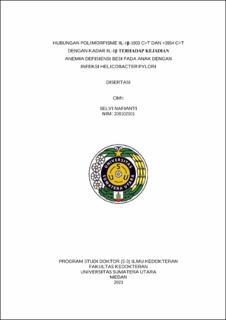| dc.contributor.advisor | Japardi, Iskandar | |
| dc.contributor.advisor | Nasution, Iqbal Pahlevi Adeputra | |
| dc.contributor.advisor | Ramayani, Oke Rina | |
| dc.contributor.author | Nafianti, Selvi | |
| dc.date.accessioned | 2024-03-20T08:30:27Z | |
| dc.date.available | 2024-03-20T08:30:27Z | |
| dc.date.issued | 2023 | |
| dc.identifier.uri | https://repositori.usu.ac.id/handle/123456789/92649 | |
| dc.description.abstract | Background: Helicobacter pylori (H. pylori) infection has long been known to
cause iron deficiency anemia. However, the data above shows that not all children
infected with H. pylori develop iron deficiency anemia. The relationship between
IL-1β gene polymorphism -1903C>T and +3954C>T with IL-1β levels and the
incidence of iron deficiency anemia in children with H. pylori infection has never
been studied before.
Purpose: To analyze the relationship between IL-1β-1903C>T and + 3954 C>T
polymorphism with IL-1β levels and the incidence of iron deficiency anemia in
children with H. pylori infection.
Methods: This was a cross-sectional study in which subjects infected with H. pylori
were examined once for IL-1β-1903C>T and + 3954 C>T polymorphisms with IL-
1β levels and the incidence of iron deficiency anemia. The research was carried out
during January 2022 - January 2023, at H. Adam Malik Hospital Medan and its
affiliations. The target population in this study were pediatric patients aged 2-18
years who experienced recurrent abdominal pain, nausea and vomiting. The sample
was taken by consecutive sampling. Subjects were taken for blood sampling for IL-
1β examination (ELISA) and polymorphism (PCR) as well as diagnostic tests of
iron deficiency anemia, while the diagnosis of H. pylori infection was done by
endoscopy (CLO)
Results: The studi subjects consisted of 52 children with 26 of them have H. pylori
(+), of these 26 children, 23 had iron deficiency anemia (prevalence ratio 11.5 (95%
CI3.015-43.864). This means H. pylori infection (+) are 11.5 times more likely to
have iron deficiency anemia than children with H. pylori (-). The difference of IL-
1β-1903C>T and + 3954 C>T gene polymorphism between H. pylori (+) and H.
pylori (-) was found to be insignificant with p = 0.329 and 1,000 respectively. There
was a significant relationship between IL-1β levels between H. pylori (+) children
(1.2 (0.7-2.6) and H. pylori (-) (0.86(0.18)) with p<0.001. Accuracy level of IL-1β
(≥0.95 pg/mL) in predicting IDA in children with abdominal pain has a sensitivity
value of 80% with a specificity value of 70.4 % The accuracy level of IL-1β levels
(≤1.3 pg/mL) in predicting IDA has a sensitivity value of 87% and a specificity
value of 66.7%.
Conclusion: There is a significant relationship between H. pylori infection and iron
deficiency anemia. No significant relationship was found between the genotypes of
IL-1β-1903C>T and + 3954 C>T polymorphism and H. pylori infection. IL-1β
levels differed significantly in children with infection H. pylori (+) compared to H.
pylori (-). | en_US |
| dc.language.iso | id | en_US |
| dc.publisher | Universitas Sumatera Utara | en_US |
| dc.subject | Helicobacter pylori | en_US |
| dc.subject | Iron Deficiency Anemia | en_US |
| dc.subject | IL-1β level | en_US |
| dc.subject | Polymorphisms | en_US |
| dc.subject | SDGs | en_US |
| dc.title | Hubungan Polimorfisme IL-1β-1903 C>T dan +3954 C>T dengan Kadar IL-1β terhadap Kejadian Anemia Defisiensi Besi pada Anak dengan Infeksi Helicobacter Pylori | en_US |
| dc.type | Thesis | en_US |
| dc.identifier.nim | NIM208102001 | |
| dc.identifier.nidn | NIDN0021077308 | |
| dc.identifier.nidn | NIDN0001027401 | |
| dc.identifier.kodeprodi | KODEPRODI11001#Ilmu Kedokteran | |
| dc.description.pages | 153 Pages | en_US |
| dc.description.type | Disertasi Doktor | en_US |




